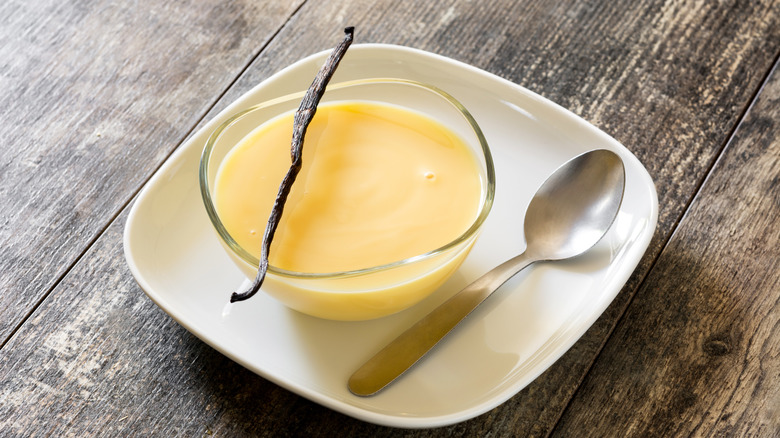The Origin Of Custard Dates Back To The Middle Ages
Custard is just one of those desserts that just sweeps you off your feet. It is thick, creamy, sweet, and often flavored with the most delicious vanilla. Some of its charm stems from its simplicity — it doesn't look like much. It resembles an egg and milk-based sweet that you scrape out of a dish or plop into a waiting bowl. That being said, it truly is a rich and divine sweet and has been enjoyed throughout history.
Crafty Baking says that custard is traditionally made from egg yolks, cream, vanilla, and sugar. Some are made using a thickener like flour or starch to help them hold together, but it's optional. Custards are usually made either on the stovetop or baked in the oven, and then cooled until serving. They are quite versatile and can be made with any number of additional ingredients, like lemon, berries, or nuts. There are over a dozen different kinds of custard-based desserts we can think of right off the top of our heads including crème brûlée, zabaglione, and bread pudding. Our love of the custard dates back further than most people realize.
Custard is older than you might think
Custards are not a modern dish. On the contrary, they've been popular for quite a few centuries. According to The Ocelot, the basics of custards (a heated milk and egg mixture) have been a fairly prevalent part of European cuisine. There is a record of custard existing since the days of ancient Rome. There is also a recipe for "Crustardes of flessh," which sounds vaguely terrifying in a 14th-century cookbook. Most commonly in the Middle Ages, custards were used alongside pastries to make tarts. In fact, the word "custard" comes from the French word, "croustade," which is a pastry crust.
British Food History claims that by the 17th century, set custards had grown in popularity. Ovens were becoming more advanced, and that is when dishes like crème brûlée were invented. Food Timeline confirms that people had been playing around with custard for centuries before. However, the Middle Ages were truly the period of time when the dish began to flourish in both savory and sweet varieties — and not just in Europe, but around the world, including in Asia. Next time you decide to whip up one of your favorite custard dishes, remember that you are partaking in a well-beloved and ancient tradition that even the Romans partook in.

